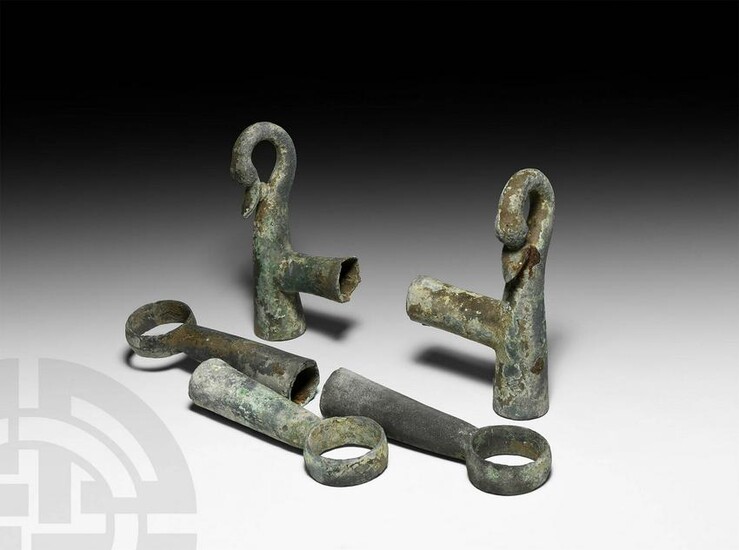Roman Chair Fittings with Swan Heads
1st-2nd century AD. A group of five bronze elements from a fulcrum, the support part of the lectus used in the triclinium; two formed as swan heads. See Daremberg, C.V. & Saglio, E. (eds.), Dictionnaire des Antiquités Grecques et Romaines, Paris, 1873-1917. 1.4 kg total, 13.6-14cm (5 1/4 - 5 1/2"). Property of an Austrian private collector since the 1970s. The word fulcrum derives from the verb fulcio, meaning a support, bed post or bed (lectus) used by the Romans during meals. Propertius in his elegies (IV,7) mentions the bed upon which the lovers lay after they had eaten: '…I dreamt last night of Cynthia, dead and buried to blaring funeral trumpets. Returned, she leaned over the bed (fulcro) in which I lay asleep as soundly as back in those nights of love’s utter exhaustion…' Virgil in the Aeneid (VI,604) also uses 'aurea fulcra' with the meaning of golden pillars. The Romans, like the Greeks, ate whilst reclined on beds. The eating bed (lectus triclinaris) was a luxury furniture item crafted by carpenters using all of their imagination. From the 2nd century BC, Romans started to create 'lecti aerati, inargentati, inaurati, eborati, testudinei,' i.e. beds made of wood and covered with bronze, silver, gold and ivory fittings (as in our specimens) or with scales of other precious material. Such elements were sometimes sculpted in the shape of an animal protome. For this specific lot, 5% import VAT is applicable on the hammer price [5]
Condition Report: Fine condition.
View it on
Estimate
Time, Location
Auction House
1st-2nd century AD. A group of five bronze elements from a fulcrum, the support part of the lectus used in the triclinium; two formed as swan heads. See Daremberg, C.V. & Saglio, E. (eds.), Dictionnaire des Antiquités Grecques et Romaines, Paris, 1873-1917. 1.4 kg total, 13.6-14cm (5 1/4 - 5 1/2"). Property of an Austrian private collector since the 1970s. The word fulcrum derives from the verb fulcio, meaning a support, bed post or bed (lectus) used by the Romans during meals. Propertius in his elegies (IV,7) mentions the bed upon which the lovers lay after they had eaten: '…I dreamt last night of Cynthia, dead and buried to blaring funeral trumpets. Returned, she leaned over the bed (fulcro) in which I lay asleep as soundly as back in those nights of love’s utter exhaustion…' Virgil in the Aeneid (VI,604) also uses 'aurea fulcra' with the meaning of golden pillars. The Romans, like the Greeks, ate whilst reclined on beds. The eating bed (lectus triclinaris) was a luxury furniture item crafted by carpenters using all of their imagination. From the 2nd century BC, Romans started to create 'lecti aerati, inargentati, inaurati, eborati, testudinei,' i.e. beds made of wood and covered with bronze, silver, gold and ivory fittings (as in our specimens) or with scales of other precious material. Such elements were sometimes sculpted in the shape of an animal protome. For this specific lot, 5% import VAT is applicable on the hammer price [5]
Condition Report: Fine condition.



